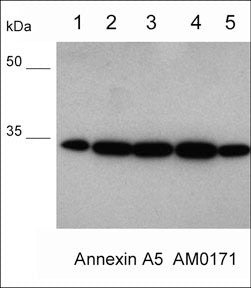Anti-Annexin A5 Antibody
- SPECIFICATION
- CITATIONS
- PROTOCOLS
- BACKGROUND

Application
| WB |
|---|---|
| Primary Accession | P08758 |
| Host | Mouse |
| Clonality | Mouse Monoclonal |
| Isotype | IgG1 |
| Clone Names | M017 |
| Calculated MW | 35937 Da |
| Gene ID | 308 |
|---|---|
| Other Names | Annexin A5, Anchorin CII, Annexin V, Annexin-5, Calphobindin I, CBP-I, Endonexin II, Lipocortin V, Placental anticoagulant protein 4, PP4, Placental anticoagulant protein I, PAP-I, Thromboplastin inhibitor, Vascular anticoagulant-alpha, VAC-alpha, ANXA5, ANX5, ENX2, PP4 |
| Target/Specificity | The Annexin family is composed of at least thirteen mammalian genes (Annexin A1-13). These proteins are characterized by a conserved core domain which binds to phospholipids in a Ca2+-dependent manner and a unique amino terminal region which may confer binding specificity. Annexins have roles in membrane fusion, endocytosis, secretion, and repair. Annexin A1 binds to cellular membranes in a calcium-dependent manner, promotes membrane fusion and endocytosis, and has been implicated as an anti-inflammatory mediator. Annexin A2 is a cytoskeletal calcium-dependent phospholipid binding protein, which has been shown to be a mediator of corticosteroid activity, a substrate for serine/threonine kinases and growth regulated tyrosine kinases, and may play a role in secretion. Annexin A5 is a PKC inhibitor, directly interacts with VEGFR2 receptor, and binds phosphatidylserine to inhibit blood coagulation. Annexin A6 reverses transformation of A431 cells after overexpression, and this effect may involve annexin A6 targeting of p120 RasGAP to the plasma membrane to inactivate Ras. |
| Format | Protein G Purified |
| Storage | Maintain refrigerated at 2-8°C for up to 6 months. For long term storage store at -20°C in small aliquots to prevent freeze-thaw cycles. |
| Precautions | Anti-Annexin A5 Antibody is for research use only and not for use in diagnostic or therapeutic procedures. |
| Shipping | Blue Ice |

Thousands of laboratories across the world have published research that depended on the performance of antibodies from Abcepta to advance their research. Check out links to articles that cite our products in major peer-reviewed journals, organized by research category.
info@abcepta.com, and receive a free "I Love Antibodies" mug.
Provided below are standard protocols that you may find useful for product applications.
Background
The Annexin family is composed of at least thirteen mammalian genes (Annexin A1-13). These proteins are characterized by a conserved core domain which binds to phospholipids in a Ca2+-dependent manner and a unique amino terminal region which may confer binding specificity. Annexins have roles in membrane fusion, endocytosis, secretion, and repair. Annexin A1 binds to cellular membranes in a calcium-dependent manner, promotes membrane fusion and endocytosis, and has been implicated as an anti-inflammatory mediator. Annexin A2 is a cytoskeletal calcium-dependent phospholipid binding protein, which has been shown to be a mediator of corticosteroid activity, a substrate for serine/threonine kinases and growth regulated tyrosine kinases, and may play a role in secretion. Annexin A5 is a PKC inhibitor, directly interacts with VEGFR2 receptor, and binds phosphatidylserine to inhibit blood coagulation. Annexin A6 reverses transformation of A431 cells after overexpression, and this effect may involve annexin A6 targeting of p120 RasGAP to the plasma membrane to inactivate Ras.
If you have used an Abcepta product and would like to share how it has performed, please click on the "Submit Review" button and provide the requested information. Our staff will examine and post your review and contact you if needed.
If you have any additional inquiries please email technical services at tech@abcepta.com.













 Foundational characteristics of cancer include proliferation, angiogenesis, migration, evasion of apoptosis, and cellular immortality. Find key markers for these cellular processes and antibodies to detect them.
Foundational characteristics of cancer include proliferation, angiogenesis, migration, evasion of apoptosis, and cellular immortality. Find key markers for these cellular processes and antibodies to detect them. The SUMOplot™ Analysis Program predicts and scores sumoylation sites in your protein. SUMOylation is a post-translational modification involved in various cellular processes, such as nuclear-cytosolic transport, transcriptional regulation, apoptosis, protein stability, response to stress, and progression through the cell cycle.
The SUMOplot™ Analysis Program predicts and scores sumoylation sites in your protein. SUMOylation is a post-translational modification involved in various cellular processes, such as nuclear-cytosolic transport, transcriptional regulation, apoptosis, protein stability, response to stress, and progression through the cell cycle. The Autophagy Receptor Motif Plotter predicts and scores autophagy receptor binding sites in your protein. Identifying proteins connected to this pathway is critical to understanding the role of autophagy in physiological as well as pathological processes such as development, differentiation, neurodegenerative diseases, stress, infection, and cancer.
The Autophagy Receptor Motif Plotter predicts and scores autophagy receptor binding sites in your protein. Identifying proteins connected to this pathway is critical to understanding the role of autophagy in physiological as well as pathological processes such as development, differentiation, neurodegenerative diseases, stress, infection, and cancer.



